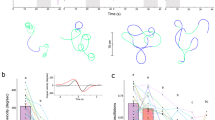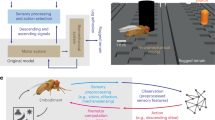Abstract
Insects rely extensively on visual information for navigation, utilizing a combination of innate instincts and learned behaviors. The mushroom body (MB) has been identified as a key player in insect visual learning, with insects possessing bilateral MBs. However, the mechanisms underlying the interaction between the left and right MBs, and how innate and learned visual cues are integrated for accurate navigation, remain elusive. In this study, we employ a novel approach wherein visual models fusing MB and innate are initially provided with binocular (left and right) visual inputs, followed by the application of a bio-plausible vector-summation method to integrate binocular innate and learned (MB) visual guidance. We verify the efficacy of this integration method by reproducing recently published data from biologists, thus providing computational support for empirical findings. This research not only sheds light on the potential mechanism for integrating bilateral innate and learned visual cues in the insect brain but also offers insights that could inspire efficient solutions for information fusion in robotics.
Application Demonstration and Industrialization of Reconfigurable Digital Intelligent Control Technology for Flexible Platforms (Grant No.CXTD2020001); National Natural Science Foundation of China under the Grant No.62206066.
Access this chapter
Tax calculation will be finalised at checkout
Purchases are for personal use only
Similar content being viewed by others
References
Ardin, P., Peng, F., Mangan, M., Lagogiannis, K., Webb, B.: Using an insect mushroom body circuit to encode route memory in complex natural environments. PLoS Comput. Biol. 12(2), e1004683 (2016)
Aso, Y., et al.: The neuronal architecture of the mushroom body provides a logic for associative learning. elife 3, e04577 (2014)
Aso, Y., et al.: Mushroom body output neurons encode valence and guide memory-based action selection in drosophila. elife 3, e04580 (2014)
Bairlein, F., et al.: Cross-hemisphere migration of a 25 g songbird. Biol. Let. 8(4), 505–507 (2012)
Brenner, E., Smeets, J.B.: Two eyes in action. Exp. Brain Res. 170, 302–311 (2006)
Buehlmann, C., Dell-Cronin, S., et al.: Impact of central complex lesions on innate and learnt visual navigation in ants. J. Comp. Physiol. A 209(4), 737–746 (2023). https://doi.org/10.1007/s00359-023-01613-1
Buehlmann, C., Mangan, M., Graham, P.: Multimodal interactions in insect navigation. Anim. Cogn. 23(6), 1129–1141 (2020)
Buehlmann, C., Wozniak, B., Goulard, R., Webb, B., Graham, P., Niven, J.E.: Mushroom bodies are required for learned visual navigation, but not for innate visual behavior, in ants. Curr. Biol. 30(17), 3438–3443 (2020)
Collett, M., Chittka, L., Collett, T.S.: Spatial memory in insect navigation. Curr. Biol. 23(17), R789–R800 (2013)
Efron, B., Tibshirani, R.J.: An Introduction to the Bootstrap. Chapman and Hall/CRC (1994)
Eschbach, C., et al.: Circuits for integrating learned and innate valences in the insect brain. elife 10, e62567 (2021)
Freas, C.A., Spetch, M.L.: Varieties of visual navigation in insects. Anim. Cogn. 26(1), 319–342 (2023)
Goulard, R., Buehlmann, C., Niven, J.E., Graham, P., Webb, B.: A unified mechanism for innate and learned visual landmark guidance in the insect central complex. PLoS Comput. Biol. 17(9), e1009383 (2021)
Habenstein, J., Amini, E., Grübel, K., El Jundi, B., Rössler, W.: The brain of cataglyphis ants: neuronal organization and visual projections. J. Comp. Neurol. 528(18), 3479–3506 (2020)
Heinze, S.: Unraveling the neural basis of insect navigation. Curr. Opin. Insect Sci. 24, 58–67 (2017)
Heinze, S.: Visual navigation: ants lose track without mushroom bodies. Curr. Biol. 30(17), R984–R986 (2020)
Heinze, S., et al.: A unified platform to manage, share, and archive morphological and functional data in insect neuroscience. eLife 10, e65376 (2021)
Hoinville, T., Wehner, R.: Optimal multiguidance integration in insect navigation. Proc. Natl. Acad. Sci. 115(11), 2824–2829 (2018)
Kamhi, J.F., Barron, A.B., Narendra, A.: Vertical lobes of the mushroom bodies are essential for view-based navigation in Australian myrmecia ants. Curr. Biol. 30(17), 3432–3437 (2020)
Kim, S.S., Rouault, H., Druckmann, S., Jayaraman, V.: Ring attractor dynamics in the drosophila central brain. Science 356(6340), 849–853 (2017)
Le Moël, F., Stone, T., Lihoreau, M., Wystrach, A., Webb, B.: The central complex as a potential substrate for vector based navigation. Front. Psychol. 10, 380097 (2019)
Mitchell, R., Shaverdian, S., Dacke, M., Webb, B.: A model of cue integration as vector summation in the insect brain. Proc. R. Soc. B 290(2001), 20230767 (2023)
Müller, J., Nawrot, M., Menzel, R., Landgraf, T.: A neural network model for familiarity and context learning during honeybee foraging flights. Biol. Cybern. 112, 113–126 (2018)
Rayshubskiy, A.: Neural Control of Steering in Walking Drosophila. Ph.D. thesis, Harvard University (2020)
Schwarz, S., Clement, L., Haalck, L., Risse, B., Wystrach, A.: Compensation to visual impairments and behavioral plasticity in navigating ants. bioRxiv (2023)
Sun, X., Mangan, M., Yue, S.: An analysis of a ring attractor model for cue integration. In: Biomimetic and Biohybrid Systems: 7th International Conference, Living Machines 2018, Paris, France, July 17–20, 2018, Proceedings 7, pp. 459–470. Springer (2018)
Sun, X., Yue, S., Mangan, M.: A decentralised neural model explaining optimal integration of navigational strategies in insects. Elife 9, e54026 (2020)
Sun, X., Yue, S., Mangan, M.: How the insect central complex could coordinate multimodal navigation. Elife 10, e73077 (2021)
Takemura, S., et al.: A connectome of a learning and memory center in the adult drosophila brain. Elife 6, e26975 (2017)
Thiagarajan, D., Sachse, S.: Multimodal information processing and associative learning in the insect brain. Insects 13(4), 332 (2022)
Wystrach, A., Philippides, A., Aurejac, A., Cheng, K., Graham, P.: Visual scanning behaviours and their role in the navigation of the Australian desert ant Melophorus bagoti. J. Comp. Physiol. A 200, 615–626 (2014)
Author information
Authors and Affiliations
Corresponding author
Editor information
Editors and Affiliations
Rights and permissions
Copyright information
© 2025 The Author(s), under exclusive license to Springer Nature Switzerland AG
About this paper
Cite this paper
Sun, Q., Sun, X., Li, H. (2025). Binocular Vision and Vector-Summation Based Integration of Bilateral Innate and Learned Visual Cues in Insect Navigation. In: Szczecinski, N.S., Webster-Wood, V., Tresch, M., Nourse, W.R.P., Mura, A., Quinn, R.D. (eds) Biomimetic and Biohybrid Systems. Living Machines 2024. Lecture Notes in Computer Science(), vol 14930. Springer, Cham. https://doi.org/10.1007/978-3-031-72597-5_9
Download citation
DOI: https://doi.org/10.1007/978-3-031-72597-5_9
Published:
Publisher Name: Springer, Cham
Print ISBN: 978-3-031-72596-8
Online ISBN: 978-3-031-72597-5
eBook Packages: Computer ScienceComputer Science (R0)




